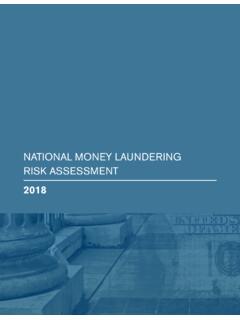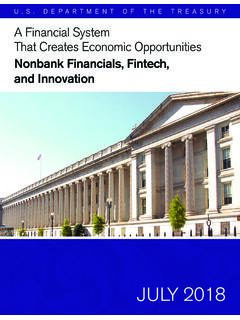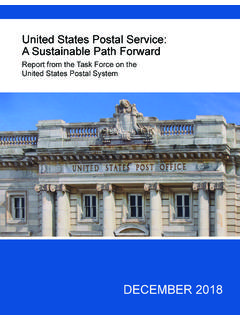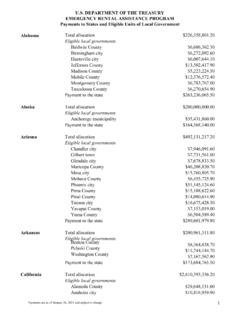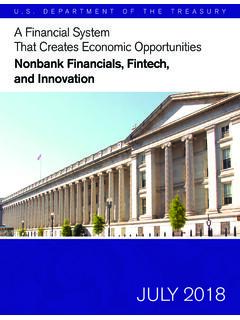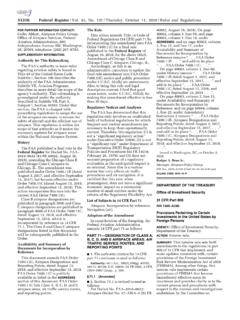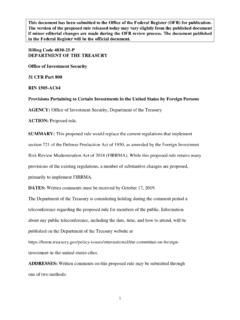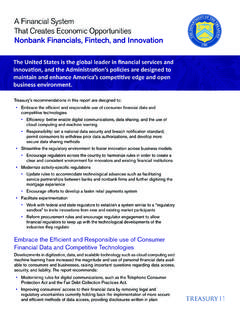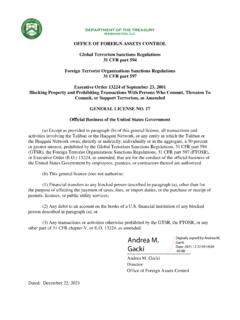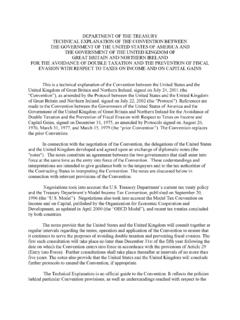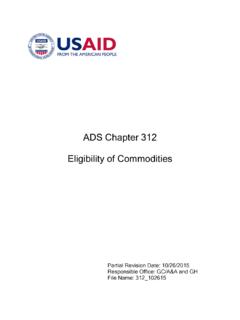Transcription of REPORT TO CONGRESS Macroeconomic and - …
1 R EP O RT TO CO NG R E SS. Macroeconomic and Foreign Exchange Policies of Major Trading Partners of the united States DEPARTMENT OF THE treasury . OFFICE OF INTERNATIONAL AFFAIRS. May 2019. Contents EXECUTIVE SUMMARY .. 1. SECTION 1: GLOBAL ECONOMIC AND EXTERNAL DEVELOPMENTS .. 10. ECONOMIC TRENDS .. 10. INTERNATIONAL ECONOMIC TRENDS .. 14. ECONOMIC DEVELOPMENTS IN SELECTED MAJOR TRADING PARTNERS .. 21. SECTION 2: INTENSIFIED EVALUATION OF MAJOR TRADING PARTNERS .. 38. KEY CRITERIA .. 38. SUMMARY OF FINDINGS .. 41. GLOSSARY OF KEY TERMS IN THE REPORT .. 43. This REPORT reviews developments in international economic and exchange rate policies and is submitted pursuant to the Omnibus Trade and Competitiveness Act of 1988, 22. 5305, and Section 701 of the Trade Facilitation and Trade Enforcement Act of 2015, 19 4421.
2 1. 1 The treasury Department has consulted with the Board of Governors of the Federal Reserve System and International Monetary Fund (IMF) management and staff in preparing this REPORT . Executive Summary Global growth decelerated in the second half of 2018, weighed down by slowing activity in China and the euro area, though growth in the united States remained strong. More recent data suggest that the global slowdown persisted in early 2019, with signs of sluggish growth across several major regions of the global economy. While there is good reason to think that at least part of this weakness will prove transitory in the united States, strong underlying fundamentals are likely to sustain solid growth going forward, and China's growth appears to be stabilizing on the back of recently enacted support measures major economies should proactively pursue policies that will bolster confidence and help raise both near-term and medium-term growth.
3 The Administration's focus is on helping American workers and businesses to thrive, raising productivity, and increasing real median incomes. Following the first major reform of the tax code in three decades, the united States saw business investment and productivity accelerate notably in 2018. The President's Budget for FY 2020, released in March, aims to bring down the fiscal deficit over the medium term by curtailing spending, with the deficit falling to percent of GDP by 2024 under the Administration's proposals and policies. The Administration is working actively to dismantle unfair barriers to trade and achieve fairer and more reciprocal trade with major trading partners. This includes combatting unfair currency practices that facilitate competitive advantage, such as unwarranted intervention in currency markets.
4 The trade agreement incorporates commitments that all three countries will avoid unfair currency practices and publish related economic information. Additionally, in March, Korea for the first time reported publicly on its foreign exchange intervention. treasury welcomes this important development in Korea's foreign exchange practices. treasury continues to carefully monitor developments in the Chinese renminbi (RMB). The RMB depreciated by percent against the dollar during the second half of 2018 and is down 8 percent over the past year to RMB to the dollar. China's exchange rate practices continue to lack transparency, including its intervention in foreign exchange markets. Based on treasury estimates, direct intervention in foreign exchange markets by the People's Bank of China (PBOC) over the last several months appears limited.
5 Nonetheless, given China's long history of facilitating an undervalued currency through protracted, large-scale intervention in the foreign exchange market, treasury has continued to have ongoing discussions with the Chinese authorities about RMB. developments and intervention practices. Moreover, in recent years, China has shifted from a policy of gradual economic liberalization to one of reinforcing state control and increasing reliance on non-market mechanisms. The pervasive use of explicit and implicit subsidies and other unfair practices are increasingly distorting China's economic relationship with its trading partners. These actions tend to limit Chinese demand for and market access to imported goods, leading to a wider trade surplus. Indeed, the united States goods trade deficit with China reached a 1.
6 Record $419 billion in 2018. A key driver of this increase was a sharp decline in exports to China in the fourth quarter of 2018, a time when imports from China were sustained. the united States is committed to addressing our persistent bilateral trade deficit to improve trade patterns between our countries and provide better outcomes for workers and firms. In recent years, there has been a decline in the scale and persistence of foreign exchange intervention among most major trading partners. Nonetheless, some trading partners have a history of one-sided intervention in foreign exchange markets. Starting with this REPORT , treasury will review and assess developments in a larger number of trading partners in order to monitor for external imbalances and one-sided intervention. treasury will also continue to monitor closely the extent to which intervention by our trading partners is symmetrical, and whether economies that choose to smooth exchange rate movements resist depreciation pressure in the same manner as appreciation pressure.
7 treasury has pushed other economies to allow exchange rates to be supportive of growth and adjust to shifting economic conditions. All G-20 members concurred last year that strong fundamentals, sound policies, and a resilient international monetary system are essential to the stability of exchange rates, contributing to strong and sustainable growth and investment. Notwithstanding these positive developments, the Administration remains deeply concerned by the large trade imbalances in the global economy. The trade deficit widened further in 2018, as domestic demand growth picked up in the united States while slowing in major trading partners, and the currencies of several major trading partners continued to be undervalued per estimates by the International Monetary Fund (IMF). Bilateral trade deficits with several major trading partners, particularly China, remain extremely large.
8 The rise in the dollar's real effective exchange rate in 2018, if sustained, would likely exacerbate these large trade imbalances. Further, global growth is neither sufficiently strong nor balanced. Large trade and current account surpluses have persisted in several major economies for many years. These imbalances pose risks to future growth, as rapid adjustments to lower imbalances have in the past typically occurred through demand compression in deficit economies, and a corresponding shortfall in demand and growth globally. These risks are intensified by the persistence of imbalances, which are causing net creditor and net debtor positions to expand as a share of global output. treasury will continue to press major trading partners that have maintained large and persistent external surpluses to support stronger and more balanced global growth by reorienting Macroeconomic policies to support stronger domestic demand growth, while durably avoiding foreign exchange and trade policies that facilitate unfair competitive advantage.
9 2. treasury Analysis Under the 1988 and 2015 Legislation The Omnibus Trade and Competitiveness Act of 1988 (the 1988 Act ) requires the Secretary of the treasury to provide semiannual reports to CONGRESS on international economic and exchange rate policy. Under Section 3004 of the 1988 Act, the Secretary must: consider whether countries manipulate the rate of exchange between their currency and the united States dollar for purposes of preventing effective balance of payments adjustments or gaining unfair competitive advantage in international trade.. This determination is subject to a broad range of factors, including not only trade and current account imbalances and foreign exchange intervention (criteria under the second piece of legislation discussed below), but also currency developments, exchange rate practices, foreign exchange reserve coverage, capital controls, and monetary policy.
10 The Trade Facilitation and Trade Enforcement Act of 2015 (the 2015 Act ) calls for the Secretary to monitor the Macroeconomic and currency policies of major trading partners and conduct enhanced analysis of and engagement with those partners if they trigger certain objective criteria that provide insight into possibly unfair currency practices. Under the 2015 Act, treasury establishes thresholds for three specific criteria. Starting with this REPORT , treasury is expanding the number of trading partners covered in the REPORT and adjusting the thresholds for the three criteria. Box 1 summarizes the changes that treasury is making. Box 1. New treasury Thresholds Under the 2015 Act Beginning with this REPORT , Previous New treasury will assess all Criteria Benchmark threshold threshold trading partners whose bilateral Total Bilateral goods trade with the united Major Trading Goods Trade 12 largest $40 billion1.
